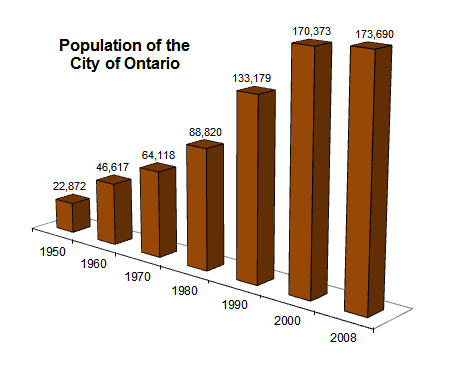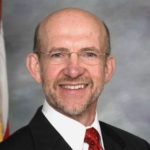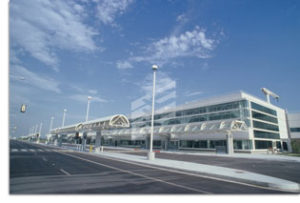 The City of Ontario has emerged as a hub for the Inland Empire. Ontario has experienced astonishing growth as its population doubled between 1980 and 2000. At the same time, income distribution has also improved, with more residents rising out of poverty and achieving increasingly higher income levels. Previously one of the citrus capitals of the world, Ontario’s economy has evolved and diversified. Ontario has taken advantage of its location to become a trade and logistics center, handling the mass of freight traffic between the Ports of Los Angeles and Long Beach and the rest of the country. The city is also home to one of the largest shopping centers in California, the Ontario Mills, which receives more annual visitors than Disneyland, and the newly constructed Citizens Business Bank Arena, the largest entertainment venue in the Inland Empire. The Ontario International Airport is the 15th busiest cargo airport in the United States and has the potential to become one of the busiest airports in the country as other Southern California airports are pushed over capacity. Inland Empire Outlook sat down with Ontario City Manager Greg Devereaux to discuss the distinctive methods the city has used to accomplish economic development even in this uncertain economy.
The City of Ontario has emerged as a hub for the Inland Empire. Ontario has experienced astonishing growth as its population doubled between 1980 and 2000. At the same time, income distribution has also improved, with more residents rising out of poverty and achieving increasingly higher income levels. Previously one of the citrus capitals of the world, Ontario’s economy has evolved and diversified. Ontario has taken advantage of its location to become a trade and logistics center, handling the mass of freight traffic between the Ports of Los Angeles and Long Beach and the rest of the country. The city is also home to one of the largest shopping centers in California, the Ontario Mills, which receives more annual visitors than Disneyland, and the newly constructed Citizens Business Bank Arena, the largest entertainment venue in the Inland Empire. The Ontario International Airport is the 15th busiest cargo airport in the United States and has the potential to become one of the busiest airports in the country as other Southern California airports are pushed over capacity. Inland Empire Outlook sat down with Ontario City Manager Greg Devereaux to discuss the distinctive methods the city has used to accomplish economic development even in this uncertain economy.

Devereaux is one of the most talented and accomplished leaders in the Inland Empire. Hailing from West Virginia, he was a theater major who initially dreamed of becoming an actor before deciding to obtain a law degree and enter government. Devereaux moved to California to accept the position of Cultural Superintendent for the City of Long Beach. He rose through the ranks there before Ontario hired him as City Manager in 1997.
As an innovative local leader, Devereaux has emphasized the importance of vision throughout an organization as well as the efficiencies created by operating a municipal government like a business. Most importantly, he believes that the key to success is finding the right people for the right jobs and always making sure to ask the right questions. Devereaux’s style of leadership has helped Ontario become an Inland Empire success story.
Q: Where is the City of Ontario today and what does its future hold?
A: The city master plan expects Ontario to grow from its current population of 175,000 to 360,000, and that is a conservative estimate. New developments in the city are going to be much denser as property values continue increasing and we try to get everything we can out of the remaining pieces of open space. The 10 and 15 freeways from Victoria Gardens to the heart of Ontario make up the main street of the Inland Empire, with two of the largest shopping malls, the airport, the Ontario Convention Center, and the arena. As the area grows, you can expect that area to be a lot denser as Class A office space moves in, mid-rise condo towers, and higher end retail. Because of the proximity of the airport, we will not be able to have high rises in the city, but we expect a lot of new office space as new tenants move to the Inland Empire to take advantage of cheaper rents and the large labor market.
The last dairies are moving out of the area and high-tech and white collar companies are moving in. The New Model Colony master planned development in the south of the city and the last open spaces near freeways such as the Meredith Property are going to be bringing in vast numbers of new residential units. These developments will bring in a density that is not common in the Inland Empire and will shift the housing stock of the city to add more homes for affluent families as well as residents at all other levels. With larger, more luxurious homes come influxes of small business, because owners of small businesses like to locate in cities where they can find nice homes for themselves nearby.
Q: What is the Complete City strategy? Is Ontario a Complete City?
A: Different cities in the Inland Empire are visibly at different stages of the Cycle of Growth described by local economist John Husing. First a city has its earliest residents move to the area, and these pioneers are often commuters to a nearby urban center. As the city grows, services follow, and jobs are created to serve the residents. By attracting more residents and offering low rents and competitive incentives, the first white collar jobs come. With the arrival of the first white collar jobs, better schools, culture, and entertainment come to an area. Once all of these are in place, the city brings in more white-collar, educated workers as well as blue collar workers to serve the community. Thus a Complete City is born that climbs the upward spiral towards success.
Ontario is well on the way to being a Complete City. It is important that the city government anticipates elements of the city that the market does not yet demand. Many of these elements take over a decade to plan, approve, and construct, and if we wait until it is obvious that the market demands them, it could be far too late and prohibitively expensive to bring them in. One example is the arena. Fifteen years ago, few people would have thought to put a 10,000 [seat arena] in the city. Today, because we planned so far ahead, it is finished in a great location and has proven to be a hugely popular venue.
Q: What sort of growth do you predict for the rest of the Inland Empire?
A: The Inland Empire as a whole will urbanize, diversify, and grow significantly. The region is one of the largest metropolitan areas in the country, something that people do not realize because we are in the shadow of Los Angeles. Rancho Cucamonga and Fontana are both over 175,000 according to the latest estimates, and they are not finished growing. By the time the Inland Empire is built out, it could have ten cities in the 100 largest in America. Today, L.A. is nearly finished growing, and the I.E. cities still have a lot of potential population growth, so you can expect this area to continue growing larger and becoming even more important.
Q: What does the future hold for Ontario Airport?

A: L.A.-Ontario Airport is currently in a lull right now because of the recession, but it has a bright future as each of the other airports in the region is maxed out. In a metropolitan region like L.A., there is a champagne glass pyramid effect with airports. As soon as the top one is full, all the ones on the level below it will fill up. John Wayne Airport in Santa Ana is full and has limits placed on it, and Long Beach and Burbank have almost no room for expansion and already have strict noise restrictions. Sometime in the future, the FAA and pressure from neighboring communities will keep LAX from expanding any further. Ontario, which has plenty of room for expansion, will grow immensely at that point. In addition, people often forget that Ontario by itself has a catchment area of over four million. As Southern California residents find themselves with fewer airport options and the Inland Empire continues to grow quickly, Ontario will grow to be a major airport. UPS and FedEx already use Ontario as a major cargo hub, avoiding the traffic and higher prices at LAX, and their operations have made it one of the busiest cargo airports in the United States.
Q: What distinguishes Ontario from other cities in the region?
A: Ontario is following what is called a Complete City Strategy. The more complete a city is, the more successful it will be in the long term. Being a Complete City involves being self-sufficient from other cities by offering enough housing and jobs for its residents at many socioeconomic levels. In Southern California, this is particularly true because the lack of transportation options makes commuting long distances an unpleasant option for many workers. A Complete City also includes services for its residents and a variety of entertainment options, transportation links, and educational centers.
Ontario is a job-rich city. An economically healthy city should have 1.3-1.5 jobs for every household within its limits. Today, Ontario is a net job importer has two jobs for every household, and as the city’s economy continues to grow and diversify, many of those jobs are white collar and high tech jobs. More companies are moving to Ontario to escape the higher rents of L.A. and Orange County and to access the huge labor and consumer market of the Inland Empire. As these companies attract educated and affluent employees, education levels in the city will continue to rise. Ontario has great entertainment options with the opening of the new arena, and the city has three freeways, an airport, and train lines within its city limits.
The city has effective and responsive business-friendly leaders who recognize the importance of strong, sustained economic growth. Cities in upward spirals feed on themselves and continue to grow, becoming more successful economically, more diverse demographically, and more educated. Ontario is in a steep upward spiral, and this will help it to be a major urban center for the region.

Sorry, comments are closed for this post.